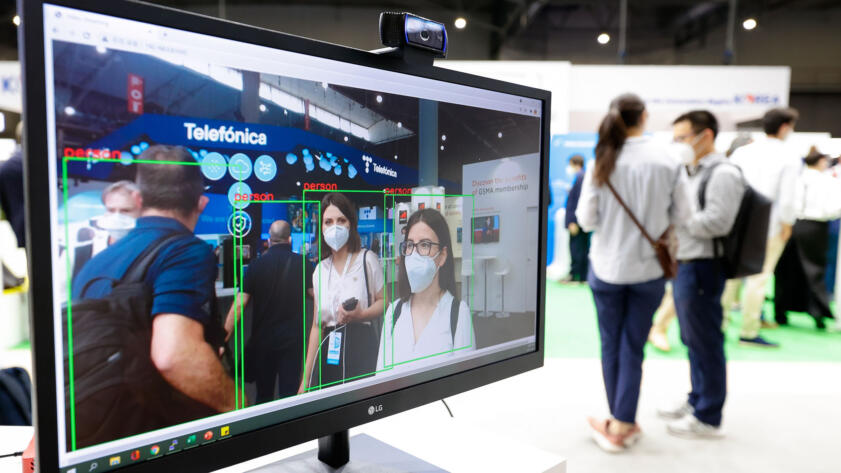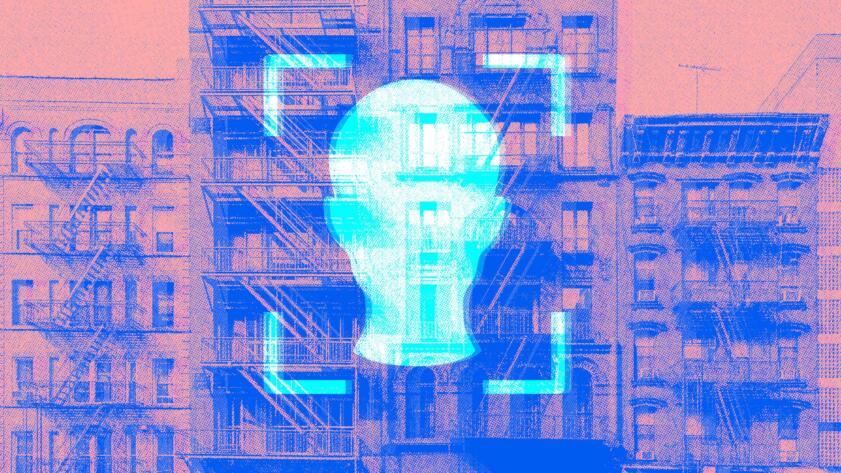The Markup, now a part of CalMatters, uses investigative reporting, data analysis, and software engineering to challenge technology to serve the public good. Sign up for Klaxon, a newsletter that delivers our stories and tools directly to your inbox.
Moving is, at best, a small nightmare. There’s the hair-pulling task of packing up and schlepping to a new location—but before you even get to that you must overcome a shortage of places to live and figure out how to afford rents that have shot to nearly 30 percent above pre-pandemic levels. On top of those challenges, many landlords are now asking renters to submit to “live selfies”—wrap-around 3D facial recognition scans to verify their identity.
Many property owners first turned to face scans during the pandemic to take some risk out of allowing self-guided tours. Now, they’re sticking with it to help lower rental application fraud and save time, since employees don’t have to handle visits. Gone are time-consuming phone calls, emails, and guided walkthroughs; in are the face scans and related technologies like smart lockboxes and scheduling software.
And it may be where you’re looking to move. Major players in this space offer listings, particularly single-family homes, from Los Angeles to Atlanta, though most don’t include New York City.
Individual renters near the end of a wearying search for a home may not think twice about a “selfie check.” But renters are already being inaccurately denied access to housing because of bad facial recognition in tenant screening processes, and consumer advocates worry that scans of people’s faces, which is biometric data, will be improperly shared, sold, stored, or used to exclude renters who can’t use them.
“Do they really need a 3D scan of your face to see an apartment?” said Jay Stanley, senior policy analyst at the American Civil Liberties Union’s (ACLU) Speech, Privacy, and Technology Project. “At what point does the burden being shifted onto people fail to justify the marginal decrease in risk the company’s going for?”
How It Works
I’ve had my own experience with these scans. For an upcoming interstate move, my fiance and I found 16 potential rental properties we wanted to see. We haven’t looked for a new rental since the pandemic, and we were surprised that we’d be touring most of the rentals alone. For 12 of them, at least one of us also had to complete a facial scan. We felt like listings were quickly becoming unavailable, so we complied.
My fiance and I found 16 potential rental properties we wanted to see. For 12 of them, at least one of us also had to complete a facial scan.
Facial recognition often comes in at one of two stages in the rental process, depending on the specific technology in use. Several rental platforms, like Rently and Invitation Homes, ask for face scans up front. Renters upload a photo of their government ID, such as a driver’s license, and then enable their phone’s front camera as the software guides them through turning their head to the left and right.
But in other circumstances renters may not have to scan their face until they are in front of the property they wish to visit. Some landlords also use facial recognition incorporated into smart lockboxes. And some platforms, such as Rently, require both–scans ahead of time and just before entering the property.
None of the rental platforms The Markup reviewed allow renters to opt out of facial recognition if they want to go on a self-guided tour.
Rently tells landlords its tech is a way to combat fraud, which it says “leads to reputational damage and revenue loss. It’s important to catch fraudsters early, before you have to pay the price for it. With Rently, your company is able to utilize built-in fraud detection technology right from the start.” Rently provides some examples of the types of fraud it says it helps fight, like scammers who steal appliances from properties or who pretend to be the landlord and give their own tours to victims who later send them money to secure the rental.
For legitimate renters, the verification process happens within seconds–or at least it’s supposed to. But the ACLU’s Stanley noted that facial recognition systems are notoriously poor when the person being scanned has a darker skin tone, which may make people of color more likely to be flagged for a false negative—and therefore refused entry to a rental. Facial recognition has a pattern of incorrectly flagging Black men and difficulty correctly identifying Black women, for example.
“[We’ve seen] cases where someone has been mixed up, for instance, with a sex offender” by an errant facial recognition match for tenant screening, said Mark Mailman, managing shareholder of consumer-focused law firm Franics Mailman Soumilas.
“[We’ve seen] cases where someone has been mixed up, for instance, with a sex offender.”
The facial recognition these companies perform is typically a one-to-one comparison, checking someone’s face against an image you provide (here, your government ID) to see if they match. This differs from facial recognition performed by companies such as Clearview AI, which try to match a face against a database of photos.
Kevin Young, spokesperson for Plaid, said in an emailed response that the company’s facial recognition helps the company differentiate if someone is “a ‘real’ person versus someone trying to hold up a printed picture that moves to make it look real.”
In a combined statement from Onfido and rental management company Mynd, Paul Jarratt, vice president of marketing communications for Onfido, said that only “pass/fail” results are shared with Mynd, and Onfido “only shares data following a binding court order or law enforcement request and with the organization requiring the checks (in this case, Mynd).”
Jarratt said on behalf of Mynd that identity verification ahead of viewing a home is “standard practice in the real estate industry to prevent fraud.”
“Mynd has a responsibility to their investors to verify that the person looking to access a home is who they claim to be,” he said.
None of the other companies contacted for this story returned The Markup’s requests for interviews.
Following the Data
For renters concerned about handing over their biometrics, it’s not always easy to readily identify listings requiring facial recognition—and when renters scan themselves, it’s difficult to know who is collecting scans of their face.
Renters may start their search on popular home listing sites such as Zillow, where those interested in a property can “request a tour” through the site’s messaging feature. They are often directed to a separate site to book the tour depending on which company manages the property, and the tour sites are where they are prompted for facial recognition.

Hello World
Face Scanning and the Freedom to "Be Stupid In Public": A Conversation with Kashmir Hill
The longtime privacy journalist on how investigating Clearview AI helped her appreciate facial recognition—and envision a chaotic future
Even then, they may need to look at the fine print of the consent box to know which firm is handling their biometrics. Identity verification is a burgeoning space whose players range from relatively new identification verification startups like Persona (started in 2018) to more established financial technology companies like Stripe (which started offering identity verification in 2021) and Plaid (whose offering dates to 2022). Most companies creating the technology do not cater to the rental industry but instead collect scans from renters when their technology is integrated into a rental website. Rently, for example, uses Plaid for its facial recognition.
Knowing which company is collecting face scans matters for how that data is handled after collection. One identity company, Onfido, says in its privacy policy that it keeps facial scans for up to 360 days before deleting them, although Jarratt said Onfido “typically” deletes scans as soon as it completes its check, keeping them longer only for a product to detect repeat fraud. The privacy policy also says Onfido keeps photos of renters’ government-issued IDs for three years and that the company will share the data with police or under a court order. Persona says it deletes data either when the verification is complete or within three years of that person interacting with Persona. It may share data with law enforcement or its third party vendors, and its policy requires that those who use its services waive their rights to a class action lawsuit against the company.
Others have far more permissive policies. Plaid’s privacy policy says it keeps the data for “no longer than necessary.” It may share data with its business partners, other companies under its corporate umbrella, law enforcement, or with a company that purchases it in the event Plaid is sold. Stripe says it retains biometrics for one year, and those who want it deleted early can contact the company via email to do so.
Some renters do not have the luxury of worrying about their biometric data because they can’t perform a scan in the first place. Face scans via a phone camera require a smartphone, technical knowhow to operate the phone and navigate the technology, and a decent internet connection. About 10 percent of Americans don’t have a smartphone, according to Pew Research Center, and about 20 percent of U.S. households didn’t have internet connectivity as of 2023, according to the U.S. Department of Commerce.
This could result in swaths of people—such as those in low- or no-connectivity areas, those without technical savvy such as the elderly, and those without a smartphone—from viewing the homes, Stanley said.
“It’s easy to see how this can have significant implications for housing,” he said.





